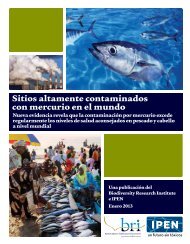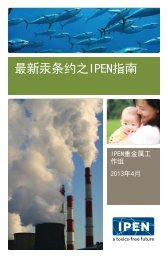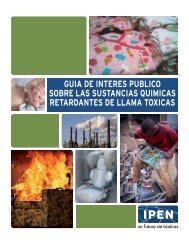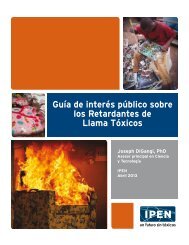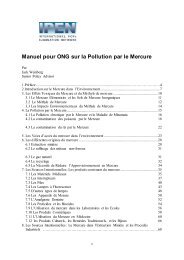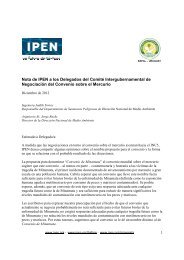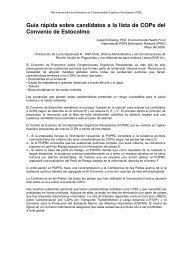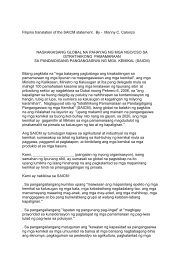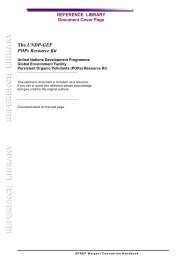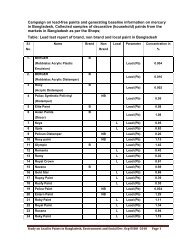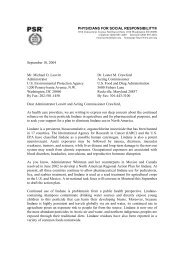A Public Interest Guide to Toxic Flame Retardant Chemicals
A Public Interest Guide to Toxic Flame Retardant Chemicals
A Public Interest Guide to Toxic Flame Retardant Chemicals
You also want an ePaper? Increase the reach of your titles
YUMPU automatically turns print PDFs into web optimized ePapers that Google loves.
and burned, creating and releasing dioxins, furans, and other <strong>to</strong>xic substances. Proper<br />
product stewardship and extended producer responsibility should include take back<br />
programs that relieve burdens on developing and transition country governments and<br />
prevent further emissions of <strong>to</strong>xic flame retardants and other byproducts during improper<br />
waste handling.<br />
7.11 ACCESS TO INFORMATION ON CHEMICALS IN PRODUCTS NEEDS TO BE<br />
IMPROVED<br />
More than 110 countries agreed on this aspect of chemical safety in a formal decision<br />
taken at the Second International Conference on <strong>Chemicals</strong> Management in 2009. Delegates<br />
agreed on the need for information on chemicals throughout their life cycle and<br />
that the information should be “…accessible, user-friendly, adequate and appropriate <strong>to</strong><br />
the needs of all stakeholders.” This is true for both developed and developing and transition<br />
countries. Information on chemicals in products should provide consumers with the<br />
information they are looking for, information which is transparent, available, accessible,<br />
clear, credible, up-<strong>to</strong>-date, comparable, appropriate <strong>to</strong> the needs of all stakeholders, and<br />
which considers substitution and alternatives. An information system on chemicals in<br />
products should help people make informed decisions about the products that they purchase,<br />
use or dispose of. For more than 170 countries that are Parties <strong>to</strong> the S<strong>to</strong>ckholm<br />
Convention, the treaty requires dissemination of information on relevant flame retardant<br />
chemicals and their health and environmental effects <strong>to</strong> policy and decision-makers,<br />
the wider public, and especially women, children, and the least educated as outlined in<br />
Article 10 of the S<strong>to</strong>ckholm Convention.<br />
7.12 CONSUMERS CAN PLAY A ROLE IN THE ADOPTION OF ALTERNATIVES<br />
IF PRODUCTS ARE LABELED<br />
If consumers are made aware of the presence of substances in products they can be<br />
empowered <strong>to</strong> make alternative choices. Labeling can play a key role in this process.<br />
This is the conclusion of the S<strong>to</strong>ckholm Convention POPs Review Committee, an expert<br />
committee of the Convention that approved a guidance document on considerations<br />
relating <strong>to</strong> alternatives and substitutes. Labels should be clear and understandable <strong>to</strong> all<br />
consumers and include safety information with the product.<br />
7.13 ALTERNATIVES TO TOXIC CHEMICALS DO NOT HAVE TO BE CHEMICALS<br />
Alternatives can include innovative changes in the design of products, industrial processes,<br />
and other practices that do not require the use of any flame retardant. This is<br />
the conclusion of the S<strong>to</strong>ckholm Convention POPs Review Committee, an expert committee<br />
of the Convention that approved a guidance document on considerations relating<br />
<strong>to</strong> alternatives and substitutes. For example, non-chemical alternatives in furniture can<br />
include synthetic fabrics or inherently flame retardant barriers that both resist smoldering<br />
sources of ignition. Electronics can be re-designed <strong>to</strong> separate high-voltage parts<br />
from outer casings or shielded with metal instead of plastic. Fire-resistive construction<br />
techniques can eliminate the need for flame retardant chemicals in insulation along with<br />
alternative materials such as natural fiber-based materials. The S<strong>to</strong>ckholm Convention<br />
alternatives guidance document states that alternative chemicals should not “...have<br />
hazardous properties that raise serious concern, such as mutagenicity, carcinogenicity<br />
A PUBLIC INTEREST GUIDE TO TOXIC FLAME RETARDANT CHEMICALS<br />
21



